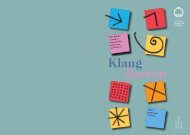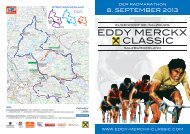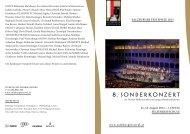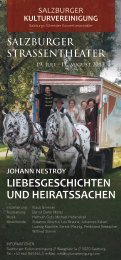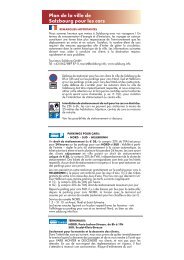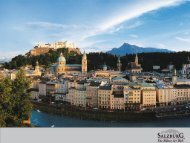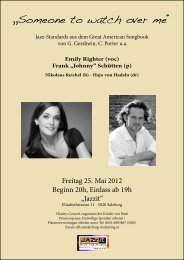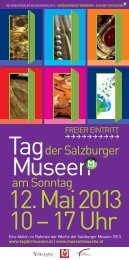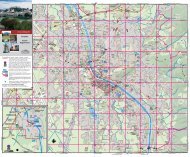Georg Trakl - Salzburg
Georg Trakl - Salzburg
Georg Trakl - Salzburg
You also want an ePaper? Increase the reach of your titles
YUMPU automatically turns print PDFs into web optimized ePapers that Google loves.
<strong>Georg</strong> <strong>Trakl</strong> - The ‘<strong>Salzburg</strong>’ Poems<br />
Translation: Will Stone
<strong>Georg</strong> <strong>Trakl</strong> - The ‘<strong>Salzburg</strong>‘ Poems<br />
<strong>Georg</strong> <strong>Trakl</strong> was not only born in <strong>Salzburg</strong>, he also lived in the town with his family<br />
until he was twenty-one years old. Later he returned for several stays of varying<br />
lengths. Thus the poet‘s formative experiences are connected to certain localities<br />
in the town and find their echo in his poems and prose. Some poems mention<br />
certain sites in <strong>Salzburg</strong> by title, while others are suggested in their pictorial<br />
metaphorical language by the architecture and different localities of the town.<br />
Since 1985, no less than nine plaques with poems engraved on them, have been<br />
mounted at such <strong>Trakl</strong>-related sites. It must be born in mind, that where he begins<br />
with external stimuli, <strong>Trakl</strong> goes on to form interior states and spaces of thought.<br />
Often he expresses images and experiences from memories of childhood. Besides<br />
images accrued from his acute sensibility for beauty, silence and human intensity,<br />
there are others that allude to an underlying feeling for transitoriness and decline.<br />
His school friend Erhard Buschbeck affirmed that to <strong>Trakl</strong> writing poetry was “his<br />
innermost concern and most lonely commitment.“
<strong>Georg</strong> <strong>Trakl</strong> employed in this poem images and impressions he would have absorbed from<br />
the window of his paternal residence at the Mozartplatz (Mozart Square) in <strong>Salzburg</strong>. They<br />
are, however, images of memory, because at the time of writing this poem he was, in fact,<br />
residing in Vienna in order to study Pharmacy. This poem stands at the crossroads between<br />
the exclusively traditionally rhymed verse from the “1909 Collection“, and the second,<br />
more mature period of his poetry – “the arduously won style, which forges together in four<br />
stanza lines four single parts of an image from a single impression,“ as he wrote in a letter<br />
to his friend Buschbeck. The specific form of the framing rhyme supports this intention.<br />
Where?<br />
On the north side of <strong>Trakl</strong>’s birthplace, at Waagplatz 1 a plaque is located, which a sculptor<br />
has rendered in bronze.<br />
The Beautiful Town<br />
Old squares sunlit silence.<br />
Deep spun in blue and gold<br />
Dreamily hasten gentle nuns<br />
Under the sultry beech trees’ silence.<br />
From brown illumined churches<br />
Gazes death’s pure images,<br />
Fine armorial bearings of mighty princes.<br />
Crowns shimmer in the churches.<br />
Horses plunge out of the fountain.<br />
Blossom claws threaten from trees.<br />
Confused in dreams boys play quietly<br />
At evening there by the fountain.<br />
Girls standing in gateways<br />
Gaze shyly on life’s gladness.<br />
Their moist lips quiver<br />
And they linger by the gateways.<br />
Fluttering chimes the bells sound.<br />
Marching beat and call of the guard.<br />
On the steps strangers listen.<br />
High in blueness theorgans sound.<br />
Shining instruments sing.<br />
Through the leaf frame of gardens<br />
Whirs the laughter of lovely women.<br />
Tenderly the young mothers sing.<br />
Stealthyodour by flowering windows<br />
Scent of incense, tar and lilac.<br />
Silvery weary eyelids shimmer<br />
Through flowers at the windows.
<strong>Georg</strong> <strong>Trakl</strong> had a particular affection for this cemetery in the old town of <strong>Salzburg</strong>. He<br />
refers to this “dream enclosed garden“ in the poem “Sebastian in Dream“ (“Or at evening<br />
holding the icy hand of his mother / He passed through St Peters autumn churchyard, /<br />
A tender corpse lay still in the darkness of the chamber.“) and in his autobiographically<br />
underlaid prose text “Dream and Derangement“ it is said: “His dreams filled the old house<br />
of the fathers. At evening he loved to cross the decayed cemetery, or he peered into the<br />
dusk of the death chamber at the corpses, the green blotches of decomposition on their<br />
beautiful hands.“ Melancholy turns into mourning.<br />
The poem was written in 1909. <strong>Trakl</strong> probably sent it from Vienna to the “<strong>Salzburg</strong>er<br />
Volksblatt“ (<strong>Salzburg</strong> Peoples Newspaper), whose editorial office was located in front of<br />
the <strong>Trakl</strong> family home at Waagplatz. It was first published there on the 10th of July, 1909.<br />
Where?<br />
On a wall on the side of the rock face, near the entrance to the churchyard, close to the<br />
funicular to the fortress.<br />
St.-Peters- Churchyard<br />
Rock loneliness is all around.<br />
The pale death flowers shudder<br />
On graves, which in darkness mourn –<br />
Yet this mourning knows no pain.<br />
Calmly heaven smiles down<br />
Into this dream-enclosed garden,<br />
Where peaceful pilgrims await it.<br />
Over every grave the cross keeps watch.<br />
The church towers up as to prayer<br />
Before an image of grace eternal,<br />
Many a candle burns beneath the arches<br />
And mutely petitions holy souls –<br />
Meanwhile the trees blossom by night,<br />
That death would his countenance conceal<br />
Within their beauty’s shimmering fullness,<br />
Which makes the dead dream deeper still.
3<br />
During his walks, <strong>Trakl</strong> liked to linger on top of the Mönchsberg, the central mountain in<br />
the city of <strong>Salzburg</strong>. Here he was able to withdraw from the demands and expectations of<br />
school and family and though in the midst of the town, he was close to nature. The “bony<br />
path“ leads into the mysterious world of myths and legends.<br />
<strong>Georg</strong> <strong>Trakl</strong> composed this poem in Innsbruck, after a sojourn in Venice in the autumn<br />
of 1913. He dedicated the first version to the architect Adolf Loos, who financed his trip<br />
to Venice; the second version was published on 1st November 1913 in the journal “Der<br />
Brenner“ – without this dedication.<br />
Where?<br />
On the Mönchsberg bastion, above the St Peters cloisters, under the Edmundsburg.<br />
Reachable via the Toscanini steps in the historical festival district.<br />
On the Mönchsberg<br />
Version II<br />
Where in the shadow of autumn elms the decayed path sinks down,<br />
Far from the huts of leaf, sleeping shepherds,<br />
Always the dark form of coolness follows the wayfarer<br />
Over the bridge of bone, the hyacinth voice of the boy<br />
Softly chanting the forgotten legend of the woods.<br />
And more gently a sick thing now the brothers wild lament.<br />
So stirs a touch of green the knee of the stranger<br />
The hardened head;<br />
Nearer the blue spring murmurs the womens’ lament.
4<br />
In this poem, <strong>Georg</strong> <strong>Trakl</strong> forms the opposition between people who are united in a loving<br />
community and the lonely one to whom the darkness permits access to an alternative<br />
reality. It emerged from the poem “Along the Walls“ and was first published in “Der<br />
Brenner“ on 14th March 1914 under the title „Ever Darker“. For the collection “Sebastian<br />
in Dream“ <strong>Trakl</strong> gave the poem its present title “In Darkness“.<br />
Where?<br />
On the façade of the ‘Engel-Apotheke’ (Angel Pharmacy) along Linzer Gasse, where <strong>Georg</strong><br />
<strong>Trakl</strong> practiced pharmacy for three years from 1905-1908 and then worked for a period of<br />
only a month. The pharmacy is now housed in a neighbouring building.<br />
In Darkness<br />
Version II<br />
Silent speaks the soul to blue springtime.<br />
Beneath damp evening branches<br />
Sank in shivers the brows of lovers.<br />
O the greening cross. In dark discourse<br />
Man and woman know each other.<br />
By the bare wall<br />
The solitary changes with his stars.<br />
Over the moonlit paths of the forest<br />
Sank the wilderness<br />
Of forgotten hunts;blue glance<br />
Breaks from decayed rocks.
Through an open window the observer gathers images of a park, whose morbid beauty<br />
speaks to him. The eerie foreboding infiltrates the outer as well as the inner world and a<br />
“white stranger“ comes upon darkness and destruction. The musical motif lends the poem<br />
a frame and makes it a “composition of words“ in the manner of Hugo von Hofmannsthal.<br />
During the first transcript of 1909, <strong>Trakl</strong> gave this poem the title, “Colourful Autumn“. In<br />
1912, in a revised version for the collection „Poems“, he rewrote the last stanza and changed<br />
the title.<br />
Where?<br />
On the eastern wall of the Mirabell Gardens.<br />
Music in the Mirabell<br />
Version II<br />
A fountain sings. Clouds stand<br />
In clear blueness, white, tender.<br />
Thoughtful people wander silent<br />
At evening through the old garden.<br />
The ancestral marble has gone grey.<br />
A flight of birds streaks to the distance.<br />
With dead eyes a faun gazes<br />
After shadows, gliding in darkness.<br />
From the old tree the leaves fall red<br />
And circle down through open windows.<br />
Firelight glows in the room<br />
And paints bleakspectres of dread.<br />
A white stranger steps into the house.<br />
A dog dashes through decayed passages.<br />
The maid turns out a lamp.<br />
Nightly are heard the sounds of sonatas.
Following his only public reading on 10th December 1913 in Innsbruck, <strong>Georg</strong> <strong>Trakl</strong><br />
composed this poem, which numbers among one of his most famous. A scene from the<br />
short novel “Of Podvelez,“ which the author Robert Michal had recited the same evening,<br />
may have proved an influence. In this tale, a man freezes to death under the most<br />
humiliating circumstances. The situation depicted in the poem does not refer directly to<br />
this, but points to the “vision“ of bread and wine. If this “Last Supper“ is prepared for the<br />
wanderer, remains unspoken.<br />
Initially the poem had the title “In Winter;“ <strong>Trakl</strong> revised it several times, especially the<br />
last stanza and changed the title at the moment of going to press. He sent a version to the<br />
revered Karl Kraus, whom he had formerly, at the bequest of “Der Brenner,“ characterized<br />
in a poem.<br />
In the evangelicals Christus-Kirche, <strong>Trakl</strong> was baptized five days after his birth on 8th<br />
February 1887. In the rectory nearby, he took part in the protestant religious instruction.<br />
Where?<br />
Near the entrance on the north side of the Christus-Kirche on Salzachkai.<br />
A Winter Evening<br />
Version II<br />
When the snow falls against the window,<br />
Long the evening bells are tolling,<br />
For many is the table prepared<br />
And the house is in good order.<br />
Many a wayfarer on his journey<br />
Comes to the gateway by dark paths.<br />
Golden blooms the tree of grace<br />
Out of the cool sap of the earth.<br />
Wayfarer steps silently inside;<br />
Pain has petrified the threshold.<br />
Then in purest radiance shines<br />
On the table bread and wine.
During his walks heading north along the Salzach, <strong>Georg</strong> <strong>Trakl</strong> would pass by, on the right<br />
hand side, beyond the railway bridge, the area of the municipal slaughter houses. Today,<br />
this is the site of a heating plant. A series of observations and perceptions about this locality<br />
are transmogrified into this poem. At the close, phantasmal dream-like images take the<br />
place of the morose and repellent slaughterhouse scenery.<br />
<strong>Georg</strong> <strong>Trakl</strong> composed this poem at the end of 1911, read it to his friend Erhard Buschbeck,<br />
who lived not far from the abattoir, and reworked it according to his objections. “It is much<br />
improved on the first version, as it is now more impersonal…“<br />
In this form it was sent to Ludwig von Ficker, the editor of the Innsbruck journal<br />
“Der Brenner,“ who published it – as the first of over sixty poems by <strong>Trakl</strong> – in the May<br />
edition of 1912.<br />
Where?<br />
On the right hand side of the Salzach, between Eisenbahn bridge and Lehener bridge,<br />
opposite the main section of the heating plant.<br />
Suburb in the Föhn<br />
At evening the area is brown and desolate,<br />
The air heavy with a greyish stench.<br />
Thunder of a train from the arch of a bridge –<br />
Andsparrows flutter over bush and fence.<br />
Huddle of huts, wild scattering of paths<br />
In gardens confusion and movement,<br />
Sometimes out of this dull stirring rises a howl,<br />
In a group of children a red dress flies.<br />
A rat choir whistles amorously by the swill.<br />
In baskets the women carry entrails,<br />
Repulsive procession of squalor and filth,<br />
They emergeout of the dusk.<br />
Suddenly a sewer spits fatty blood<br />
From the slaughterhouse into the calm river.<br />
To frugal flowers the Föhn lendscolour<br />
And slowly red creeps through the flood.<br />
A whisper, that drowns in troubled sleep.<br />
Above the water ditches juggle shapes<br />
Memories perhaps of a former life,<br />
That rise and fall on warm breezes.<br />
From clouds plunge shimmering avenues,<br />
Filled with fine coaches and bold riders.<br />
Then you see also a ship founder on rocks<br />
And sometimes rose coloured mosques.
The park of Hellbrunn palace to the south of <strong>Salzburg</strong> was one of <strong>Georg</strong> <strong>Trakl</strong>’s preferred<br />
destinations for his walks. He may have used the Stem tramway, which at that time passed<br />
by on its way from the main station to the Untersberg. The atmosphere of the location,<br />
with the palace, the trick fountains, the hills and ponds appealed powerfully to him. He is<br />
said to have even spent the night there to better sense the uncanny atmosphere. Several<br />
motifs can be traced back to these intense perceptions, for example Orpheus (the Orpheus<br />
grotto in the trick fountains) palaces and hills, cypresses and tritons.<br />
The first lyrical arrangement concerning the different nature of the three ponds originates<br />
from 1909; on the 8th April it was published in the “<strong>Salzburg</strong>er Volksblatt“. But he continued<br />
to be preoccupied with this theme and in the same year he produced a second version,<br />
which he continually revised again and again until 1914.<br />
Where?<br />
In the water gardens of the castle park of Hellbrunn, on one face of the octagonal building<br />
next to the most southerly, smallest pond holding the triton sculpture.<br />
The Three Ponds of Hellbrunn<br />
Version II<br />
Walking along black walls<br />
The evenings, silver sounds the lyre<br />
Of Orpheus in the dark pond<br />
But spring drops in showers<br />
From branches in wild showers<br />
The night wind sounds silver the lyre<br />
Of Orpheus in the dark pond<br />
Dying against the greening wall.<br />
In the distance shine castle and hill<br />
Voices of women who died long ago<br />
Weave tenderly and darkly coloured<br />
Over the white nymphs’ mirror.<br />
Lamenting their bygone fate<br />
And the day flows into the green<br />
Whispering in reeds, in waves returning–<br />
And with them a song thrush jokes.<br />
The water shimmers greenish blue<br />
And calmly breathe the cypresses<br />
And their measureless melancholy<br />
Drifts upwards in the blue evening.<br />
Triton emerges from the flood,<br />
Decay trickles across walls<br />
In green veils the moon is swathed<br />
And slowly walks above the flood.
<strong>Georg</strong> <strong>Trakl</strong> probably knew the village of Anif, to the south of <strong>Salzburg</strong>, not far from the<br />
Hellbrunn palace, from his far-reaching walks. The poem contains several memories; the<br />
first word opens this sequence. It is grounded by an awareness of the “guilt of the born.“<br />
<strong>Trakl</strong> wrote a first sketch probably in Vienna, a little later in December 1913 in Innsbruck,<br />
he produced a fair copy with the typewriter. It appeared in this form in “Der Brenner“ on<br />
1st January 1914.<br />
Where?<br />
At the municipal pavilion in Anif, near the entrance to the municipal library.<br />
Anif<br />
Memory: Gulls gliding over the dark sky<br />
Manlier melancholy.<br />
Silent you dwell in the shade of the autumn ash,<br />
Rapt in the righteous measure of the hill;<br />
Ever you walk down the green river,<br />
When evening has come,<br />
Sounding love; peacefully encounters the dark prey,<br />
A rosier man. Drunk with bluish weather<br />
The dying leaf stirs the brow<br />
And thinks the Mother’s grave countenance.<br />
O, how all sinks down into darkness;<br />
Stern rooms and the old implements<br />
Of the ancestors.<br />
These stir the stranger’s breast<br />
O, you signs and stars.<br />
Great is the guilt of the born. Woe, you golden shudder<br />
Of death,<br />
When the soul dreams cooler blossoms.<br />
Ever in bare branches the night bird calls<br />
Above the moon-one’s steps.<br />
By village walls an icy wind resounds.
Chronology<br />
1887 3rd February: <strong>Georg</strong> <strong>Trakl</strong> is born in the evening at the Schaffner house on Waagplatz<br />
in <strong>Salzburg</strong>. Parents: Tobias <strong>Trakl</strong>, Dealer in Metals, born 1837 in Ödenburg (Sopron) and Maria<br />
Catharina <strong>Trakl</strong>, born Halik, 1852 in Wiener Neustadt.<br />
1892 <strong>Trakl</strong> enters the Übungschule des Leherenseminars (primary school). Religious instruction<br />
in the protestant rectory.<br />
1897 <strong>Trakl</strong> enters the humanist k.k. Staatsgymnasium (state secondary school).<br />
1905 <strong>Trakl</strong> does not continue to seventh grade, but instead determined to train as a pharmacist<br />
and leaves school. He embarks on a period of work practice in Carl Hinterhubers pharmacy “Zum<br />
weissen Engel“ (“At the White Angel”) on the Linzer Gasse.<br />
1906 Performance of “Totentag“ (“Death day”) and “Fata Morgana“ in the Stadttheater<br />
<strong>Salzburg</strong>.<br />
1908 First appearance of a poem (“Morning Song“ in the “<strong>Salzburg</strong>er Volksblatt“). Termination of<br />
pharmacy practice, enrolls to study pharmacy at the University of Vienna.<br />
1909 At the suggestion of Erhard Buschbeck, he gathers together his poems for a first collection,<br />
or „Collection 1909“ as it is unofficially known.<br />
1910 Meeting with Oskar Kokoschka. Achieves his Master’s degree in pharmacy. Death of his<br />
father. Enters voluntarily for a year’s military practice.<br />
1911 End of military practice in Vienna. Handles prescriptions at the pharmacy „Zum weissen<br />
Engel“ , <strong>Salzburg</strong>.<br />
1912 April: Assumes a position in the pharmacy of the Garrison hospital in Innsbruck. Meets the<br />
publisher of the bi monthly journal “Der Brenner,“ Ludwig von Ficker, who regularly publishes his<br />
work. In autumn, enrolled in the reserves.<br />
1913 Acceptance of manuscript “Poems“ by Kurt Wolff Publishers (Leipzig). Moves to Vienna.<br />
Works as an accounts clerk in the war ministry. Communication with Karl Kraus and Adolf Loos. Trip<br />
to Venice. Returns to Innsbruck. Offered to give a lecture.<br />
1914 Submits the manuscript of “Sebastian in Dream“ to Kurt Wolff Publishers. Travels to Berlin<br />
to see his sister Margarethe. Meeting with Else Lasker-Schüler. Settles on the Hohenburg near Igls<br />
with Rudolf von Ficker. Receives financial aid from Ludwig Wittgenstein. War breaks out.<br />
24th August: Departs on a military convoy. <strong>Trakl</strong>’s unit, Field Hospital 7/14, are stationed in Galicia<br />
and are obliged to care for the traumatised wounded following the battle of Grodek. Stationed<br />
in West Galicia; admission to the garrison hospital in Krakow following a mental collapse and<br />
attempt at suicide.<br />
24/25 October: Visit of Ludwig von Ficker to Krakow.<br />
3rd November: <strong>Georg</strong> <strong>Trakl</strong> dies of heart failure following a dose of cocaine smuggled into his cell.<br />
Buried in the Rakoviczer cemetery in Krakow.
Publishers: Internationales <strong>Trakl</strong>-Forum der <strong>Salzburg</strong>er Kulturvereinigung. F.d.I.v.: Dr. Hans Weichselbaum. Alle: Waagplatz<br />
1a, A-5020 <strong>Salzburg</strong>, Tel. +43/(0)662/84 53 46, Fax: +43/(0)662/84 26 65, E-Mail: trakl-gedenkstaette@kulturvereinigung.<br />
com, Homepage: www.georg-trakl.at.<br />
Images: Front cover: Lithography by Jean-Paul Chambas (Paris); Inside: two sketches by Alfrd Kubin, from <strong>Trakl</strong>s ‘Dream<br />
and Derangement‘ (<strong>Georg</strong>-<strong>Trakl</strong>-Forschungs-und Gedenkstätte); Back cover: <strong>Trakl</strong>-Portrait (Lithography) by Jean Paul<br />
Chambas (© Verlag Widrich, <strong>Salzburg</strong>).



